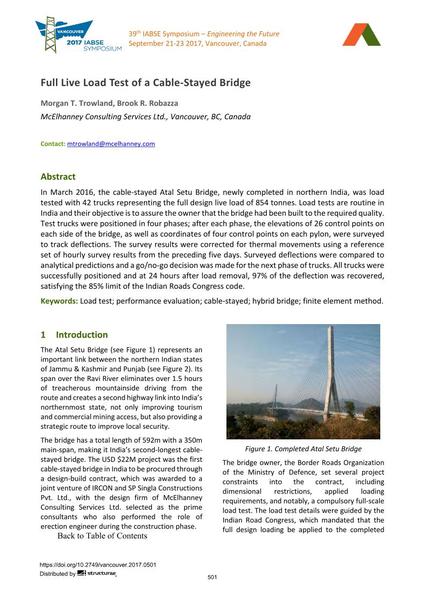Full Live Load Test of a Cable-Stayed Bridge

|
|
|||||||||||
Bibliografische Angaben
| Autor(en): |
Morgan T. Trowland
(McElhanney Consulting Services Ltd., Vancouver, BC, Canada)
Brook R. Robazza (McElhanney Consulting Services Ltd., Vancouver, BC, Canada) |
||||
|---|---|---|---|---|---|
| Medium: | Tagungsbeitrag | ||||
| Sprache(n): | Englisch | ||||
| Tagung: | IABSE Symposium: Engineering the Future, Vancouver, Canada, 21-23 September 2017 | ||||
| Veröffentlicht in: | IABSE Symposium Vancouver 2017 | ||||
|
|||||
| Seite(n): | 501-508 | ||||
| Anzahl der Seiten (im PDF): | 8 | ||||
| Jahr: | 2017 | ||||
| DOI: | 10.2749/vancouver.2017.0501 | ||||
| Abstrakt: |
In March 2016, the cable-stayed Atal Setu Bridge, newly completed in northern India, was load tested with 42 trucks representing the full design live load of 854 tonnes. Load tests are routine in India and their objective is to assure the owner that the bridge had been built to the required quality. Test trucks were positioned in four phases; after each phase, the elevations of 26 control points on each side of the bridge, as well as coordinates of four control points on each pylon, were surveyed to track deflections. The survey results were corrected for thermal movements using a reference set of hourly survey results from the preceding five days. Surveyed deflections were compared to analytical predictions and a go/no-go decision was made for the next phase of trucks. All trucks were successfully positioned and at 24 hours after load removal, 97% of the deflection was recovered, satisfying the 85% limit of the Indian Roads Congress code. |
||||
| Stichwörter: |
Finite-Elemente-Methode (FEM) FEM Belastungstest
|
||||
